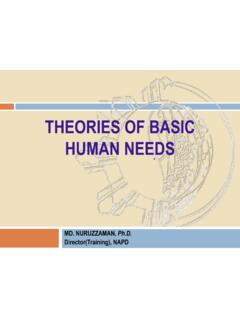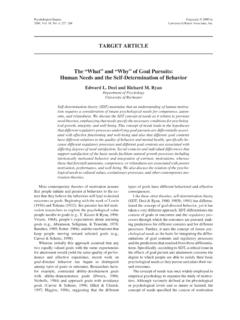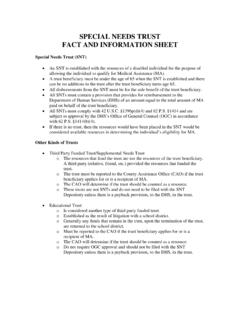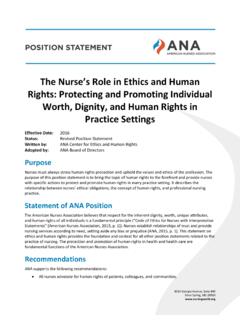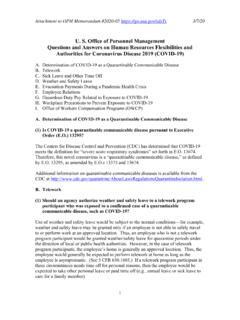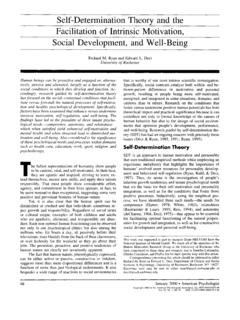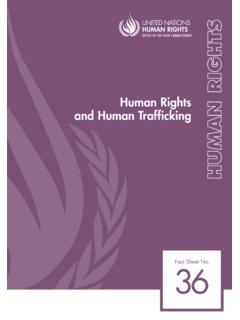Transcription of Human Needs - NASA
1 Human Needs Exploration: Then and Now Essential Questions How do people adapt to new environments? ". How will basic Needs be met in new worlds? .. Lesson Overview . This lesson investigates Human Needs and . how humans adapt to new environments. Students experiment to understand the . effects of physical stress on muscles. They ! . also identify food properties that make foods . suitable for space flight and travel during colonial times. Using the new food-guide National Science Education Standards pyramid, students create a food and activity Science as Inquiry plan for healthy eating and then modify this Physical Science plan based upon what they learn about past and present exploration. Science and Technology Science in Personal and Social Background Information Perspective Human beings have certain basic Needs . We National Health Education Standards must have food, water, air, and shelter to Demonstrate the ability to practice health- survive.
2 If any one of these basic Needs is not enhancing behavior and reduce health met, then humans cannot survive. risks. Before past explorers set off to find new lands Demonstrate the ability to use goal- and conquer new worlds, they had to make setting and decisionmaking skills to enhance health. sure that their basic Needs were met. Supplies of food and water were brought on the journey or were gathered along the way. Shelter, such as a tent, was either carried or built to protect explorers from the weather or other dangers. Basic Human Needs have not changed much since the 17th century. We continue to explore to better understand our own world and to address the modern challenges that face societies in general. Beyond the boundaries of Earth, 21st-century explorers will face a unique set of challenges as they return to the Moon, travel to Mars, and scout the far reaches of the solar system. Instructional Objectives Students will: explore the effects of physical stress on muscle.
3 Identify food properties and design tests to select suitable foods for travel during colonial times and space flight;. create a food and activity plan for healthy eating and modify the plan for 17th- century travel and 21st-century space travel; and compare the differences in challenges faced by 17th-century and 21st-century explorers. Exploration: Then and Now NASA and Jamestown Education Module EG-2006-09-25-LaRC Human Needs Page 1 of 17. Materials (Students will need journals and class charts in order to organize information throughout this lesson.). Engage Per partnership: Spring-hinge clothespin Stopwatch Explore Per group: Different food samples. Food samples may include fruits, vegetables, breads, crackers, drinks, meats, or any other readily available food. Explain Per student: NASA and Jamestown Human Needs Chart: Food/Water . NASA and Jamestown Human Needs Chart: Health Concerns . Extend Per group: Internet access Vocabulary atrophy: a decrease in size or wasting away of a body part or tissue bloodletting: a common medical practice of the 17th century consisting of draining blood from a person's body to cure specific diseases brackish water: water that is a mixture of freshwater and saltwater circadian clock: often referred to as circadian rhythm, an internal biological timer with a set number of hours.
4 Each individual has their own internal clock that appears to control biological processes, including sleep, hunger, and hormone production dysentery: an infection of the intestine that causes severe diarrhea famine: extremely low food supply that leads to starvation irradiated food: food that has been preserved by exposure to specific heat or light radiation natural form foods: foods that can be eaten without additional processing Exploration: Then and Now NASA and Jamestown Education Module EG-2006-09-25-LaRC Human Needs Page 2 of 17. proprioceptors: sensory receptors found chiefly in muscles, tendons, joints, and the inner ear that detect the motion or position of the body or a limb; some proprioceptors are found on the bottom of your feet rehydratable food: food that has been preserved by removing the water; water is added to the food before it is eaten resistive exercise: an activity that strengthens bone and muscle by pushing against a force using your own body weight thermostabilized food: food that has been preserved using heat to destroy harmful bacteria typhoid fever: an acute infection of the intestines vestibular system: a bodily system that helps regulate balance and motion and is involved with equilibrium Suggested Pacing: Engage Explore Explain Extend Evaluate Total 50-minute Completed class 1 class 2 class 1 class 1 class throughout 5 class period period periods period period the lesson periods Instructional Procedure Teaching Suggestion: Prior to beginning this lesson, create a chart that will be displayed throughout the lesson to help organize student learning.
5 Ask the students to create similar charts in their journals. The charts may be formatted as follows, but should be large enough to organize information. How do people adapt to new environments? How will basic Needs be met in new worlds? JAMESTOWN MOON. FOOD/WATER. HEALTH CONCERNS. Engage Generally, when we think of stress, we think of emotional stress, such as being overworked, mentally tired, or overwhelmed by our daily lives. You would imagine that exploring and settling new worlds would be emotionally stressful for both 17th-century explorers and 21st-century explorers. Too much emotional stress is not good for anyone. Exploration: Then and Now NASA and Jamestown Education Module EG-2006-09-25-LaRC Human Needs Page 3 of 17. Emotional stress is not the only kind of stress. Our bodies, including our muscles and bones, need some physical stress to be healthy and to grow. Gravity's pull is a force that creates physical stress for everything on Earth.
6 Living and working in a reduced- gravity environment eliminates some physical stress. Physical stress occurs when bones and muscles work against a force. It occurs when we pick up something heavy, like a large bag of potatoes. Gravity pulls down on the bag and we have to work to overcome that force to lift the bag. The resistance of water when swimming also creates physical stress. Muscles and bones have to work against the water to move the body. Gravity pulls on our bodies and our muscles and bones work to counteract that force and keep us balanced. Stress from physical activity is necessary for bone growth and maintenance. The body builds bone based on its Needs . Muscles also rebuild and grow as a result of physical stress. Stress can lead to change in either muscle strength or muscle stamina (the ability to perform an activity for a long time without becoming tired). High-intensity, short-duration exercises (or stresses), like weight lifting, cause the muscles to increase in strength.
7 Low-intensity, long-duration activities, such as running and swimming, cause muscles to increase in stamina. Much more is understood about the Human body and how it adapts to new environments today than was understood during the 17th century. The Jamestown settlers lived in cramped spaces when they traveled from England. Movement and exercise was limited. Although these cramped quarters compromised the health of the Jamestown settlers, their bodies still benefited from physical stress. This activity helps your students understand some of the benefits of gravity and physical stress. 1. Discuss the following questions as a class or ask students to write their thoughts in their journals: Imagine that you are an explorer ready to begin a new adventure. What feelings might you have before you begin your exploration? Would you be worried about having enough food, water, and air? Would your feelings be different if you were a 17th-century explorer compared to being a 21st-century explorer?
8 What is stress? Would you feel stress in both situations? 2. Discuss the differences between emotional and physical stress and discuss how/why the body Needs physical stresses, such as exercise, to be healthy. 3. Explain to students that they will be exploring the effects of physical stress on the muscles in their hands. 4. The first trial will test each student's initial muscle strength and stamina. Students will work with partners to conduct the activity following these directions: Before each trial, the first person will predict the number of times he or she will be able to click the clothespin in 1 minute. Students will create their own data chart to organize their predictions and observed data. Exploration: Then and Now NASA and Jamestown Education Module EG-2006-09-25-LaRC Human Needs Page 4 of 17. One partner will hold a clothespin in his or her nondominant hand between the thumb and index finger. The other partner will time 1 minute and count the number of times the first partner is able to click the clothespin.
9 The first person running the test will rest for 1 minute and then click the clothespin for another minute. This step will be repeated a total of three times. Partners will switch roles. 5. After students have completed all trials, ask the following questions: How do the muscles in your hand feel? How did your hand feel after the first minute? The second minute? The third minute? Why do you think this happened? 6. Every other day for the next two weeks, have students repeat this exercise. This repetition is the conditioning period. The stress induced by the clothespin on the muscles of the hand will cause the muscles to become stronger and increase stamina. Students should predict and report their results each day. 7. Discuss these questions as a class or ask students to write their thoughts in their journals: What is the difference between muscle strength and muscle stamina? How did strength and stamina change in your hand over the conditioning period?
10 Compare your predicted results and actual results. Did your predicted results improve over the course of the experiment? 8. Some current countermeasures for bone and muscle loss during long-duration space flight include nutrition and exercise. Without adequate nutrition, problems can arise for every system in the body. Ensuring that astronauts have the right nutrients in their food is critical for their health before, during, and after flight. At the same time, performing daily exercise also helps astronauts decrease bone and muscle losses. Continue the class discussion by asking these questions: What do astronauts do to counteract bone and muscle deterioration during long- duration space flight? How would a long-duration space flight compare to the trip from England to Jamestown in 1607? What must all explorers do to prepare to live in unfamiliar worlds? Teaching Suggestion: You may want to show the 30-minute NASA CONNECT . video Good Stress: Building Better Muscles and Bone to your students, found at You will find an expanded version of this activity in the NASA CONNECT educator guide at this site.










